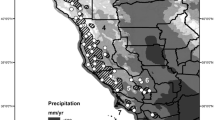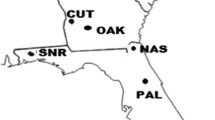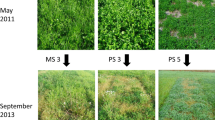Abstract
Key message
Field testing of different willow species, and promising genotypes within a species, can maximize biomass yield and quality traits due to strong genotype by environment interactions.
Abstract
Coppice yield and components of growth were quantified in eight clones of two widely distributed North American willows, Salix discolor (DIS) and S. eriocephala (ERI), in common-garden field tests on three sites of varying quality. Both species and clones within species varied significantly across different sites and interacted with site for plant yield and components of growth traits. At the species level, ERI was significantly more productive than DIS on the two most productive sites (85 and 57 % greater, respectively), but on the poorest site, a shale coal mine overburden, species ranking was reversed, with DIS showing a 60 % greater biomass yield than ERI. These sites had similar mean temperature, growing degree days, and seasonal precipitation. Site quality differences were thus most probably driven by soil nutrients, physical traits, and water-holding capacity quantified by 13 soil properties, 12 of which were significantly different and showed fairly consistent ranking among sites. At the clonal level, growth trends and differences were mostly consistent among clones across the three test sites, with the exception of one clone of DIS and to a lesser extent a clone of ERI, which showed abnormally strong clone by site interaction for specific growth traits. Productivity reached as high as 6.0 kg green mass in 2-year-old coppices for a clone from each of DIS and ERI on the most productive site. The strong expression of genetic by environment interactions at both the species and clonal levels suggests that biomass production can be optimized by taking advantage of such interactions and highlights the need for testing not only different species, but also a number of clones within a species before selecting clones for biomass production on different site types. Our results highlight variation in coppice form and the potential for genetic selection both among and within species.








Similar content being viewed by others
References
Argus GW (2010) Salix L. In: Flora of North America Editorial Committee (ed) Flora of North America North of Mexico, Volume 7. Magnoliophyta: Salicaceae to Brassicaceae. Oxford University Press, Oxford, pp 23–162
Bergkvist P, Ledin S (1998) Stem biomass yields at different planting designs and spacings in willow coppice systems. Biomass Bioenergy 14(2):149–156
Ceulemans R, McDonald AJS, Pereira JS (1996) A comparison among eucalypt, poplar and willow characteristics with particular reference to a coppice, growth modelling approach. Biomass Bioenergy 11(2/3):215–231
Chosa JA, Shetron SG (1976) Use of willow cuttings to revegetate the “slime” areas of iron mine tailings basins. Mich Tech Univ Res Note 21:5
Densmore R, Zazada JC (1978) Rooting potential of Alaskan willow cuttings. Can J For Res 8:477–479
Densmore R, Neiland BJ, Zazada JC, Masters MA (1987) Planting willow for moose habitat restoration on the North slope of Alaska, USA. Arct Alp Res 19:537–543
Environment Canada (2013). http://climate.weather.gc.ca/index_e.html
Erikson G (ed) (1988) Proceedings of the IEA Willow Breeding Symposium. Department of Forest Genet, Swedish University Agric Sci, Uppsala, Sweden. Res Notes, p 41
Goodale CL, Apps MJ, Birdsey RA et al (2002) Forest carbon sinks in the northern hemisphere. Ecol Appl 12:891–899
Guidi-Nissim WG, Pitre FE, Teodorescu TI, Labrecque M (2013) Long-term biomass productivity of willow bioenergy plantations maintained in southern Quebec, Canada. Biomass Bioenerg 56:361–369
Gullberg U (1993) Towards making willows pilot species for coppicing production. For Chron 69:721–726
Harper RJ, Beck AC, Ritson P, Hill MJ, Mitchell CD, Barrett DJ, Smettem KRJ, Mann SS (2007) The potential of greenhouse gas sinks to underwrite improved land management. Ecol Eng 29:329–341
Hicks CR (1982) Fundamental concepts in the design of experiments. Holt, Rinehart and Winston, New York 425
Hood GA, Bayley SE (2009) A comparison of riparian community response to herbivory by beavers (Castor canadensis) and ungulates in Canada’s boreal mixed-wood forest. For Ecol Manage 258:1979–1989
Houghton RA (2005) Aboveground forest biomass and the global carbon balance. Glob Change Biol 11:945–958
Intergovernmental Panel on Climate Change (2007) Fourth assessment report on climate change (2007). In: Pachauri RK, Reisinger A (eds) Synthesis report. Contribution of working groups I II, and III. Intergovernmental Panel on Climate Change, Geneva
Kopp RF, Smart LB, Maynard CA, Isebrands JG, Tuskan GA, Abrahamson LP (2001) The development of improved willow clones for eastern North America. For Chron 77(2):287–292
Kuzovkina YA, Quigley MF (2005) Willows beyond wetlands: uses of Salix L. species for environmental projects. Water Air Soil Pollut 162:183–204
Kuzovkina YA, Volk TA (2009) The characteristics of willow (Salix L.) varieties for use in ecological engineering applications: co-ordination of structure, function and autecology. Ecol Eng 35:1178–1189
Labrecque M, Teodorescu TI (2005) Field performance and biomass production of 12 willow and poplars in short-rotation coppice in southern Quebec (Canada). Biomass Bioenerg 29(1):1–9
Labrecque M, Teodorescu TI, Cogliastro A, Daigle S (1993) Growth patterns and biomass productivity in two Salix species grown under short rotation intensive culture in southwestern Quebec. Biomass Bioenerg 4(6):419–425
Ledin S (1996) Willow wood properties, production and economy. Biomass Bioenerg 11(2–3):75–83
McKeague JA (ed) (1978) Manual of soil sampling and methods of analysis, 2nd edn. Can Soc Soil Sci, Pinawa
Mola-Yudego M, Aronsson P (2008) Yield models for commercial willow biomass plantations. Biomass Bioenerg 32:829–837
Mosseler A, Zsuffa L, Stoehr MU, Kenney WA (1988) Variation in biomass production, moisture content and specific gravity in some North American willows (Salix L.). Can J For Res 18:1535–1540
Mosseler A, Major JE, Labrecque M (2014a) Growth and survival of seven native willow species on highly disturbed coal mine sites in eastern Canada. Can J For Res 44:340–349
Mosseler A, Major JE, Labrecque M, Larocque GR (2014b) Allometric relationships in coppice biomass production for two North American willows (Salix spp.) across three different sites. For Ecol Manage 320:190–196
Ronnberg-Wastljung A, Thorsen J (1988) Inter- and intraspecific variation and genotype x site interaction in Salix alba L., S. dasyclados, and S. viminalis L. Scand J For Res 3:449–463
Savoie P, Lavoie F, D’Amours L (2009) Development of two headers for a versatile woody brush harvester-baler. Appl Eng Agric 25(6):811–817
Savoie P, Hébert P-L, Robert F-S (2013) Harvest of short rotation woody crops with small to medium size forage harvesters. ASABE Paper 131620174. Presented at the American Society of Agricultural and Biological Engineers’ Annual International Meeting, Kansas City, MO, 21–24 July 2013. ASABE, St. Joseph, MI, p 14
Sennerby-Forsse L, Zsuffa L (1995) Bud structure and resprouting in coppiced stools of Salix viminalis L., S. eriocephala Michx., and S. amygdaloides Anders. Trees 9:224–234
Singer FJ, Mark LC, Cates RC (1994) Ungulate herbivory of willows on Yellowstone’s northern winter range. J Range Manage 47:435–443
Smart LB, Volk TA, Lin J, Kopp RF, Phillips IS, Cameron KD, White EH, Abrahamson LP (2005) Genetic improvement of shrub willows (Salix spp.) crops for bioenergy and environmental applications in the United States. Unasylva 221(56):51–55
Tharakan PJ, Volk TA, Abrahamson LP, White EH (2003) Energy feedstock characteristics of willow and hybrid poplar clones at harvest age. Biomass Bioenerg 25:571–580
Tharakan PJ, Volk TA, Nowak CA, Abrahamson LP (2005) Morphological traits of 30 willow clones and their relationship to biomass production. Can J For Res 35:421–431
Verwijst T (1991) Shoot mortality and dynamics of live and dead biomass in a stand of Salix viminalis. Biomass Bioenerg 1:35–39
Volk TA, Abrahamson LP, Nowak CA, Smart LB, Tharakan PJ, White EH (2006) The development of short-rotation willow in the northeastern United States for bioenergy and bio-products, agroforestry and phytoremediation. Biomass Bioenerg 30:715–727
Volk TA, Abrahamson LP, Cameron KD, Castellano P, Corbin T, Fabio E, Johnson G, Kuzovkina-Eischen Y, Labrecque M, Miller R, Sidders D, Smart L, Staver K, Stanosz GR, van Rees K (2011) Yields of willow biomass crops across a range of sites in North America. Aspects Appl Biol 112:67–74
Zsuffa L (1990) Genetic improvement of willows for energy plantations. Biomass 22:35–47
Author contribution statement
Alex Mosseler: experimental design, implementation, data collection, data analysis and write-up John Major: data analysis and write-up Michel Labrecque: data analysis and write-up.
Acknowledgments
We are grateful to Moira Campbell, Ted Cormier, John Malcolm, Joseph Mosseler, Matthew Mosseler, Don Ostaff, Jean Teodorescu, and Peter Tucker for their assistance in collection of material from natural populations, establishment of common-garden tests, and data collection from these common gardens. We also thank the Montreal Botanical Garden, Michele Coleman with Mine Restoration Inc. (a subsidiary of NB Power), and Natural Resources Canada, Canadian Forest Service for providing growing space for the common-garden tests described here, and to Jim Estey of the Laboratory for Forest Soils and Environmental Quality at the University of New Brunswick for analysis of soil samples from the sites described here.
Conflict of interest
The authors declare that they have no conflict of interest.
Author information
Authors and Affiliations
Corresponding author
Additional information
Communicated by S. Landhausser.
Rights and permissions
About this article
Cite this article
Mosseler, A., Major, J.E. & Labrecque, M. Genetic by environment interactions of two North American Salix species assessed for coppice yield and components of growth on three sites of varying quality. Trees 28, 1401–1411 (2014). https://doi.org/10.1007/s00468-014-1043-9
Received:
Revised:
Accepted:
Published:
Issue Date:
DOI: https://doi.org/10.1007/s00468-014-1043-9




